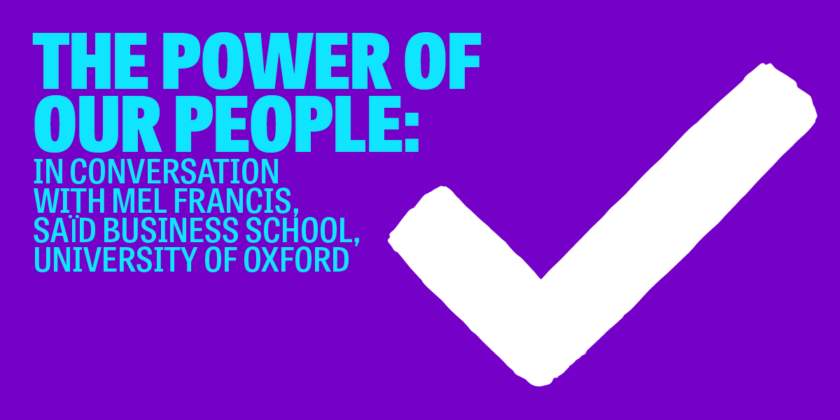Let’s Talk Talent recently partnered with Saїd Business School, University of Oxford to bring a fresh perspective to their HR strategy. Here, Mel Francis, HR Director of Saїd Business School talks to Let’s Talk Talent about her team’s journey so far and building a high-performance organisation.
I joined SaÏd Business School seven years ago having worked for Vodafone and then Oxford University Press. Moving from a commercial environment to an 800-year-old academic institution was an enormous change! But my professional experience gave me a fresh perspective that enabled me to prioritise what I needed to change to create a high performing team and organisation. We recently reached a point at which I felt we’d benefit from an external perspective to help us shape our future.
What it’s really like to work at the University of Oxford?
Saїd Business School is only 21 years old so we’re like an adolescent in an incredibly mature, complex institution. I knew I wanted to create a professional HR team, which is now the only one of its type at the University, but there are historical complexities and barriers that I’d not faced before.
There are expectations about the way we work, the way we behave, even the way documents should look. Many of the HR processes seemed antiquated to someone arriving from the commercial world. So, when choosing someone to work with on our HR strategy I wanted them to have that HRD perspective but also be realistic about the practical and tactical changes we need to make.
Building a professional HR team
I’m proud that we now have such a professional HR function. It hasn’t been easy given the complex governance structures at the university. However, we’ve built a fantastic team of nine HR professionals including three in-house recruiters, four in operations and wellbeing and a head of L&D. Together we are responsible for 460 staff.
What had to change?
Before I had the opportunity to grow a high-performing team there was some fire-fighting to be done.
- Prioritisation of HR resource: When I first arrived, we seemed to be being pulled from one building to another based on who was shouting loudest! The team was involved in processes like payroll and had too many conflicting priorities – priorities that had not been set by the HR agenda.
- Relinquishing responsibility: The remit of the team was too broad. I took the decision to relinquish responsibility for academic staff who require very different support to professionals. Faculty and Researchers now have support from Faculty Services so we can focus on supporting non-academic staff.
- Bringing recruitment in house: When I arrived, every vacancy was placed with an external agency at great expense and not always successfully. I now have three in-house recruiters who are actively expanding our visibility on LinkedIn and training other staff to do so. Sharing our messages online is really helping to build our employer brand and 98% of vacancies are now filled by the internal recruitment team.
- Addressing culture and wellbeing: We ran a wellbeing survey in 2015 that highlighted issues in our culture, some of which resulted in disrespectful behaviour towards staff. There is a perceived imbalance in power between faculty and professional staff that we’re addressing through our operations team that supports the employee lifecycle from onboarding onwards.
- Building a performance culture: Historically there has been a culture of incremental pay rises based on a salary band and length of service and a cost of living increase. Therefore, there was an expectation of a pay rise regardless of performance. Linking performance to reward is something we are exploring.
Working with Let’s Talk Talent
I can talk about our vision and journey for the future, but I wanted the process to be inclusive and for our output to be a joint effort that we all put our stamp on. I knew we’d benefit from an external perspective to help us visualise and quantify that we wanted to achieve next.
We embarked on a project with Let’s Talk Talent that began with a two-day offsite meeting. This was a first for us and we thoroughly enjoyed the time we had under Jo and Kursty’s guidance. The offsite commenced with a fireside chat about our goals and what was actually realistic in terms of expertise and budget.
Over the course of the two days, Jo and Kursty encouraged us to articulate our feelings, aspirations, frustrations as we worked our way through the Let’s Talk Talent model of being a great place to work. Jo and Kursty’s input was invaluable in helping us visualise our journey. Their understanding of our challenges and their ability to take our thoughts and feelings and bring them to life meant we ended the meeting firm aims for our strategy. Jo and I have since worked together to turn that into an achievable plan.
The journey ahead
As a team and with the support of Let’s Talk Talent, we’ve created an action plan that includes our objectives for the next two years. This is a culmination of six months’ work and we’re looking forward to the next phase of our journey.
I have a great team and I know they have options about whether to stay. The commitment I make to my team is that we will make the most of the time we are together and that you will leave the team in a better place than when you joined it. This is why it was important to plan our journey ahead together.
To find out more about how Let’s Talk Talent helps companies shape their HR vision and strategy please contact us.
